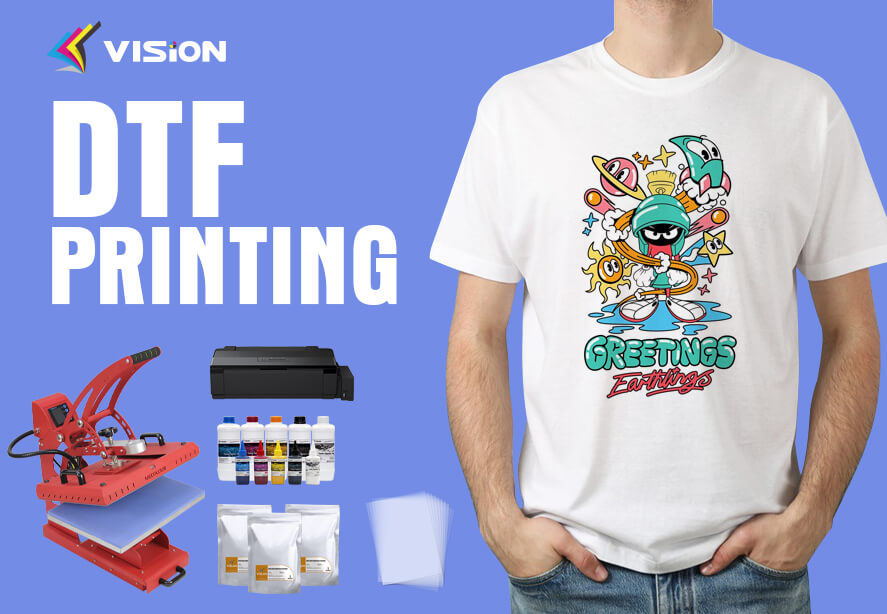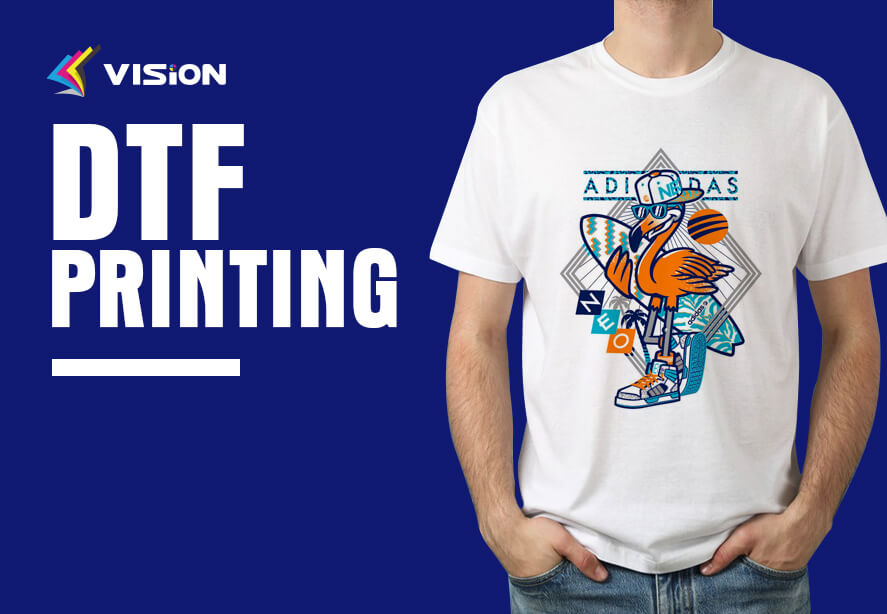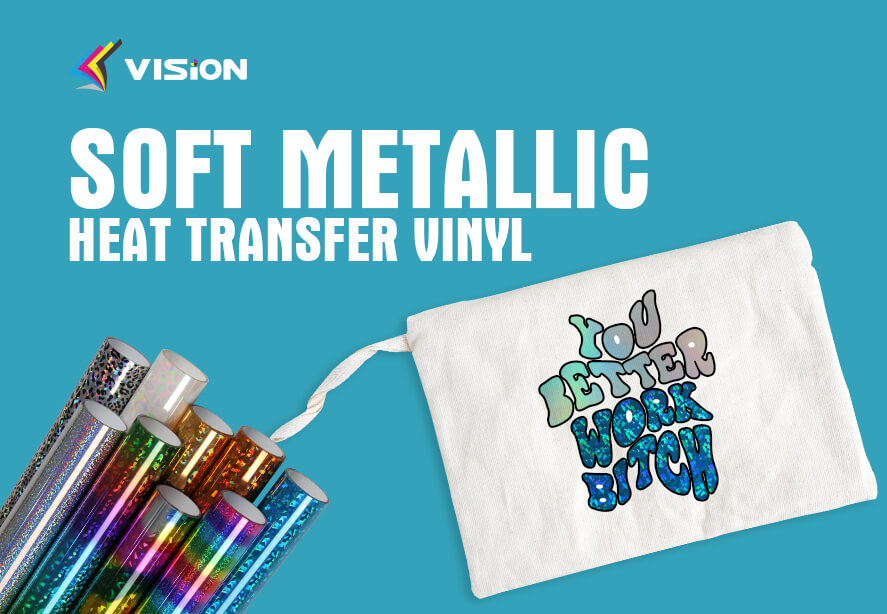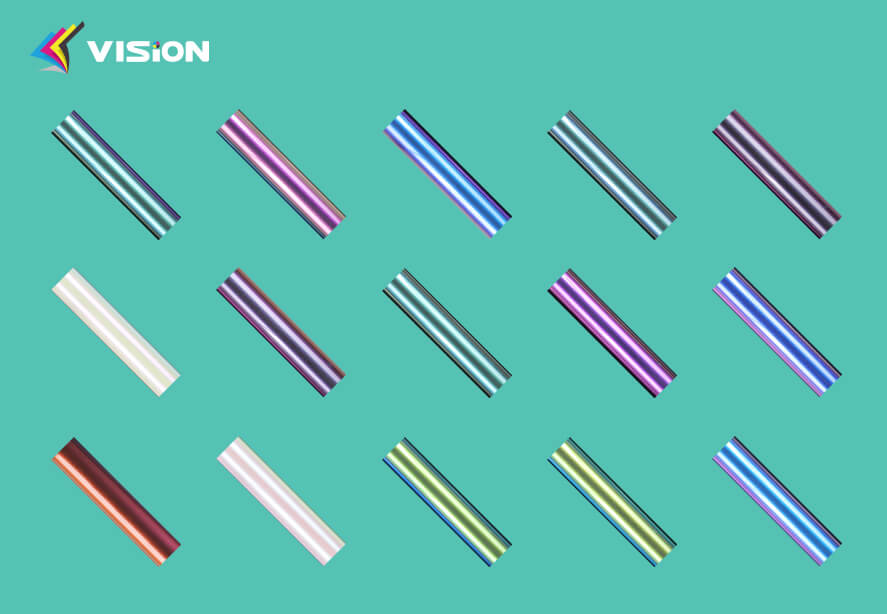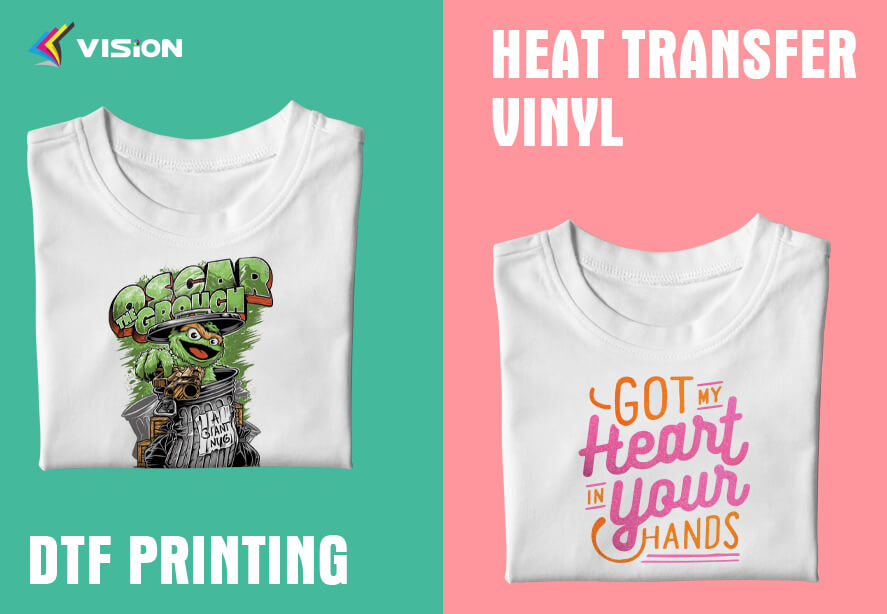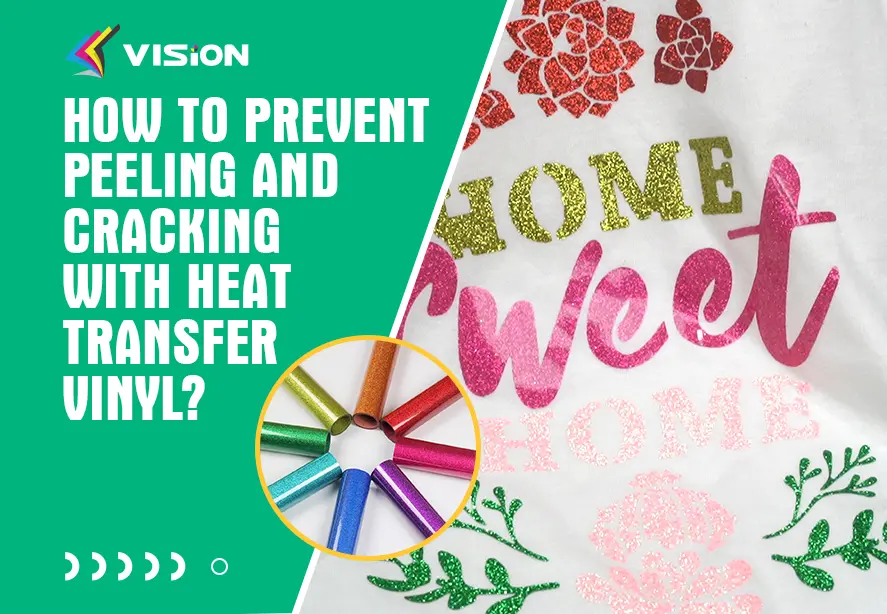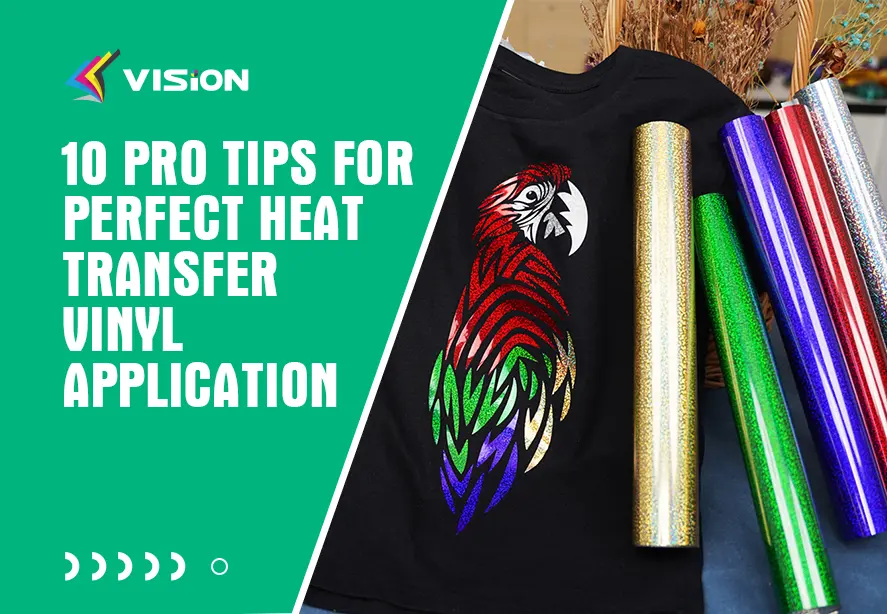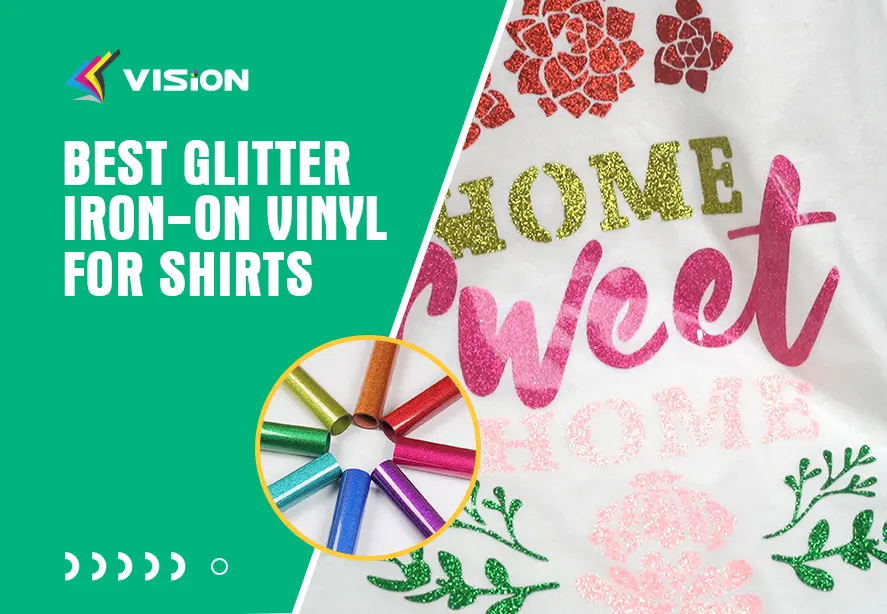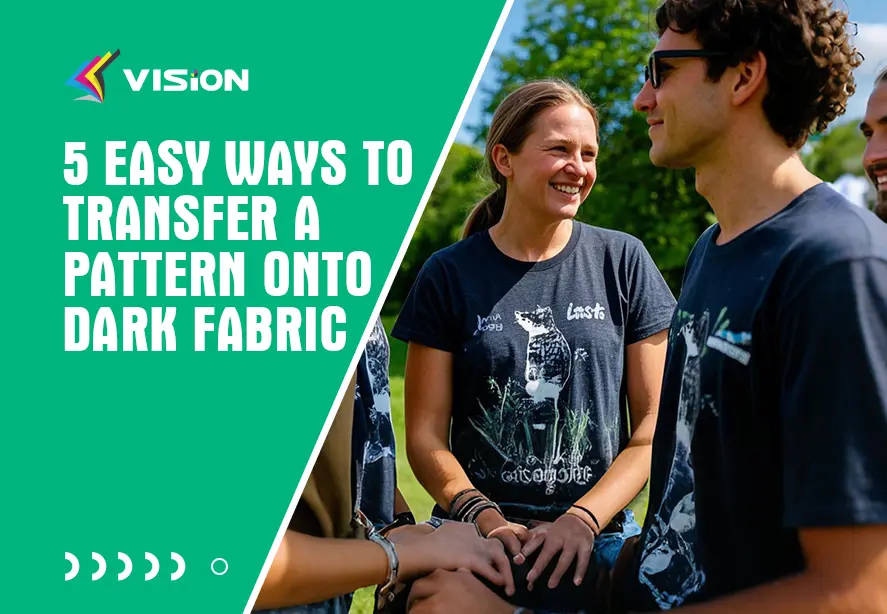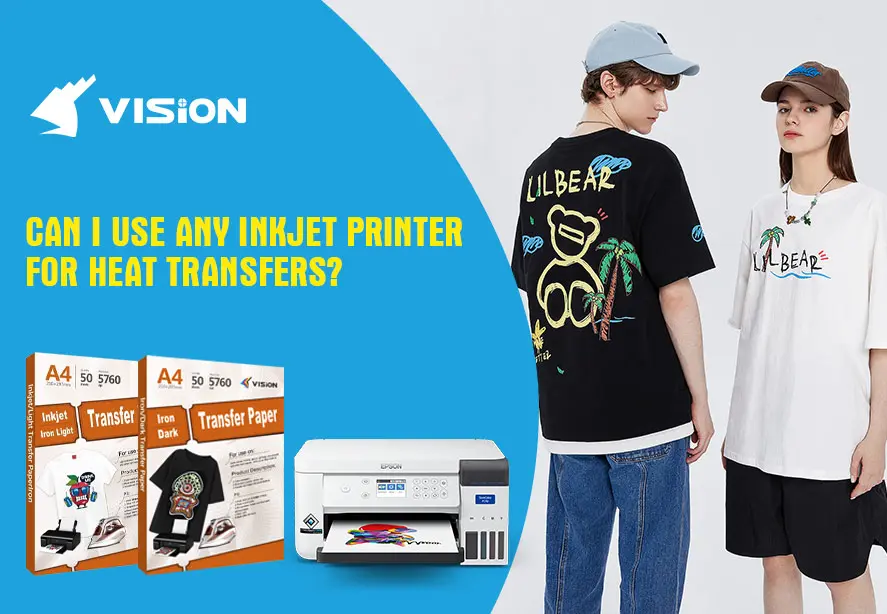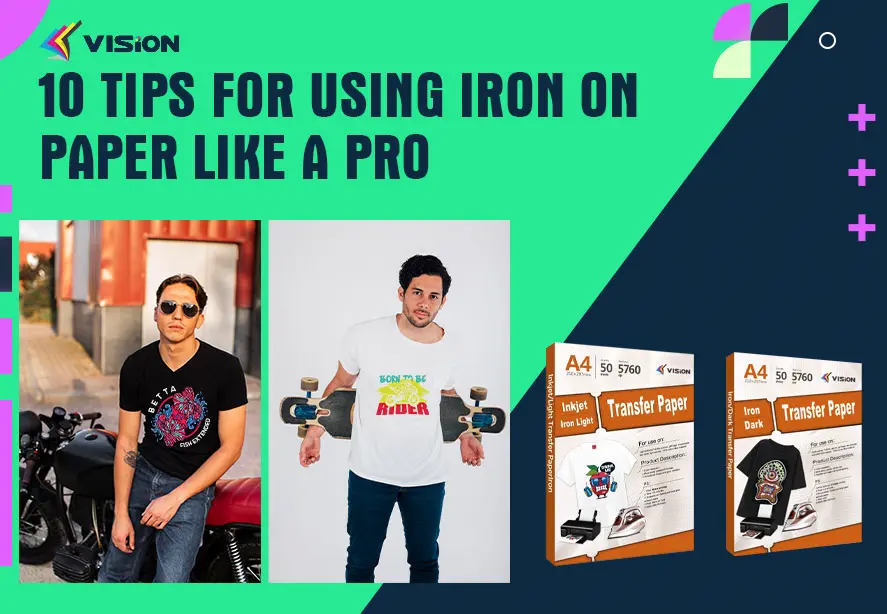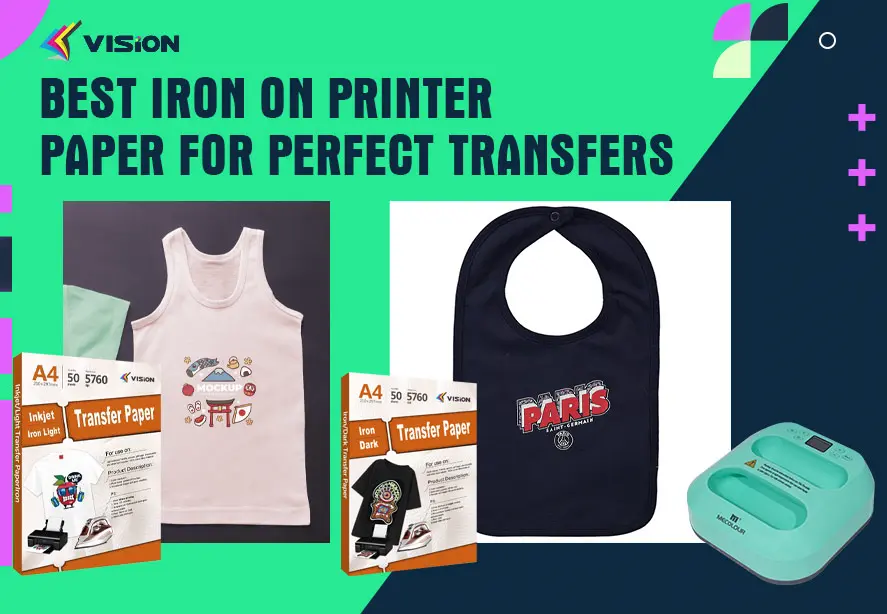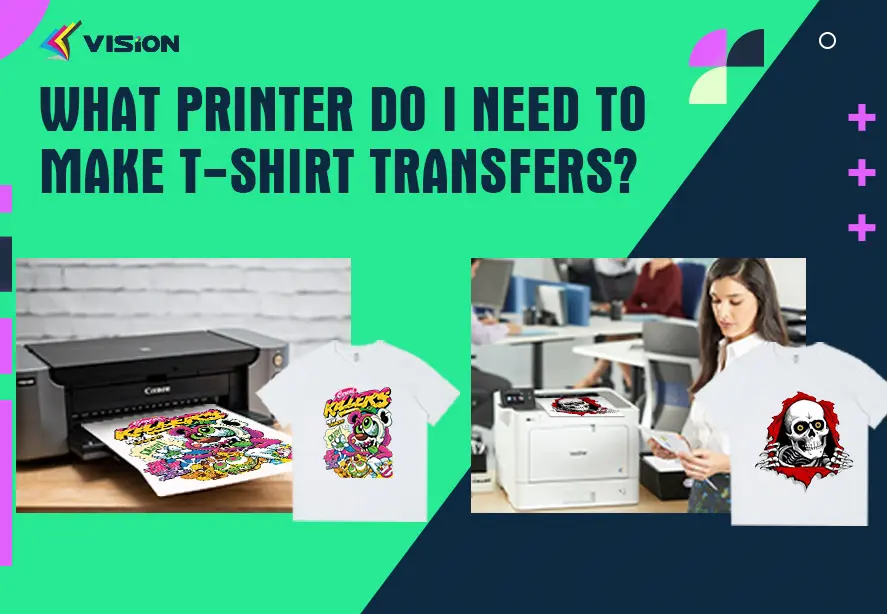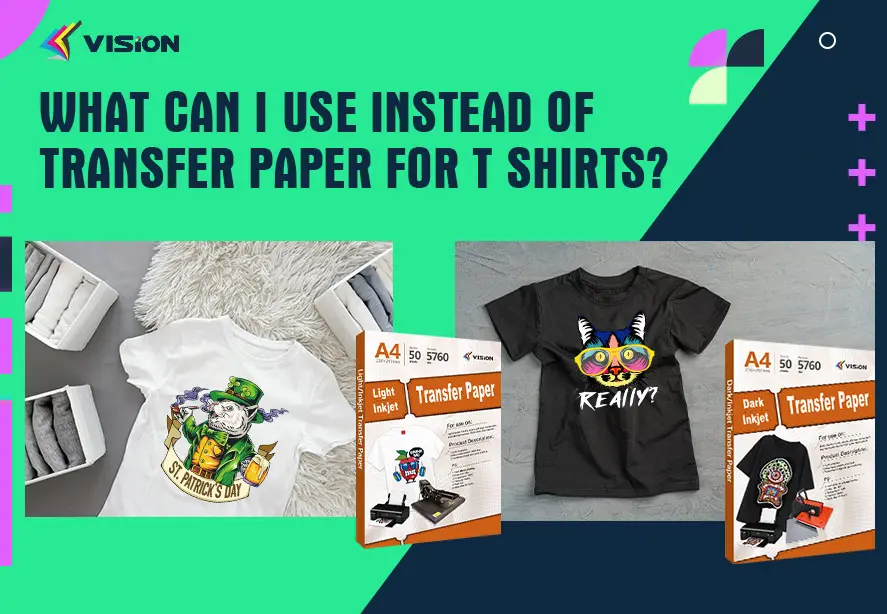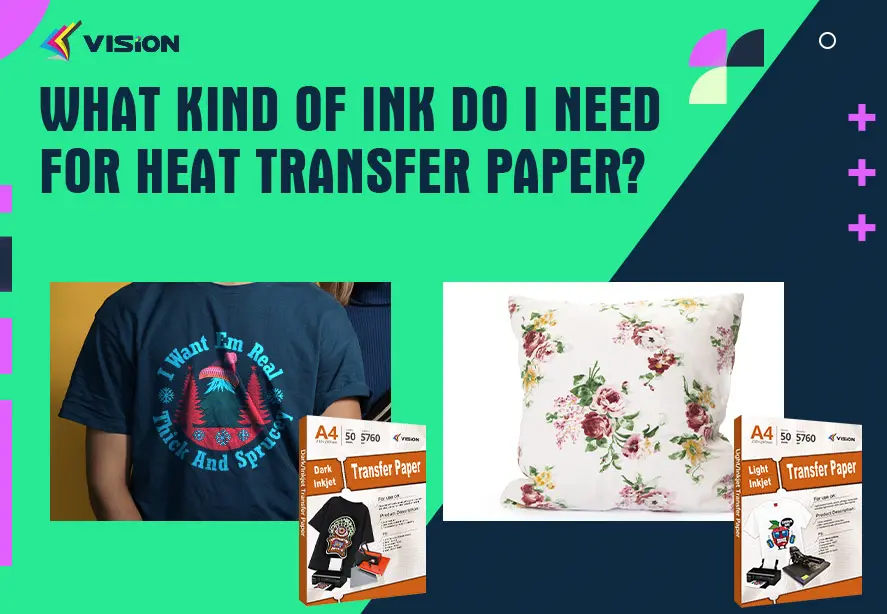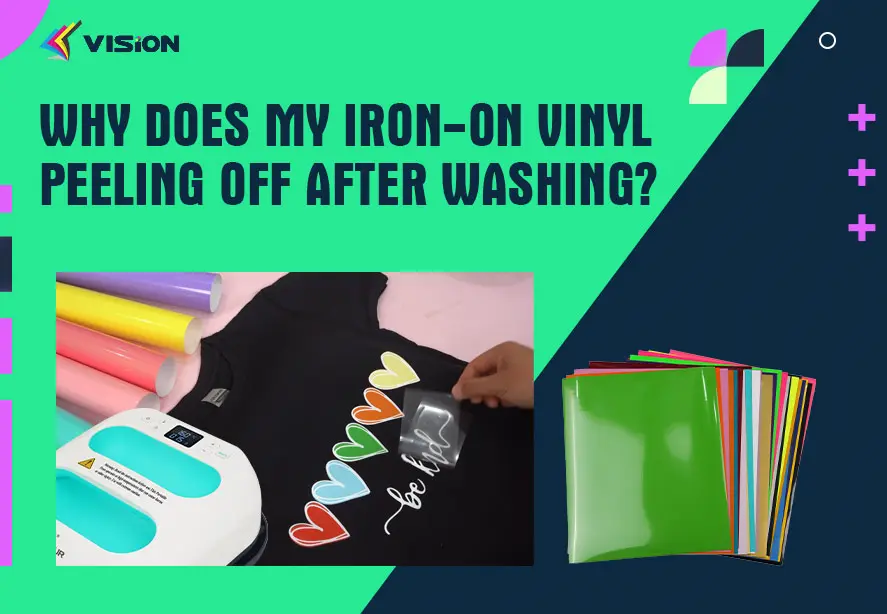DTF Printing vs Heat Transfer Vinyl: Which is beneficial for your business?
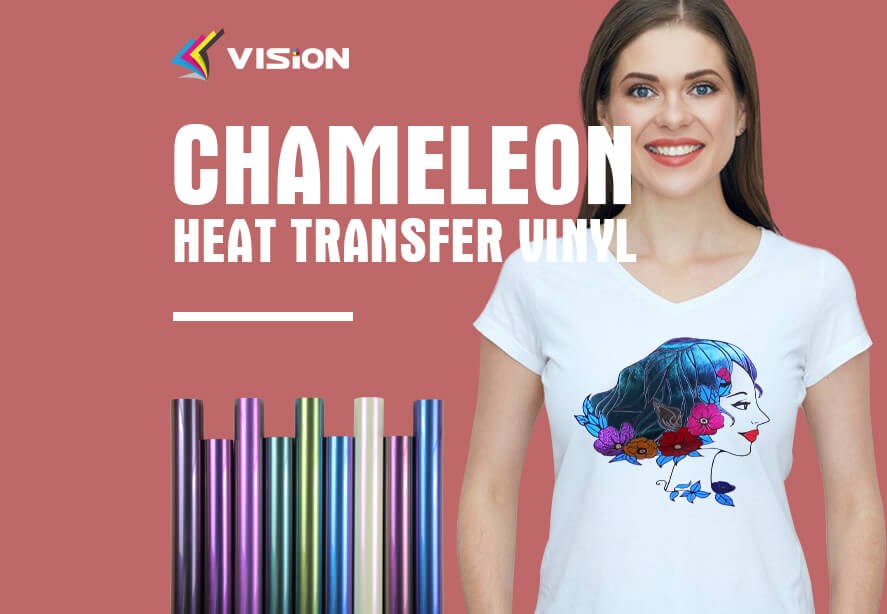
DTF Printing (Direct to Film printing) and Heat Transfer Vinyl are two popular methods of transferring designs onto fabrics.
So, if you are considering using heat transfer printing method as your new business to expand your customer base, which is the better choice?This article will help you identify the pros and cons of DTF printing and HTV. We’ll compare their similarities and differences and help you figure out which one of these printing methods is beneficial for your business?
Table of Contents
- What is DTF Printing?
- What is needed for DTF printing?
- How does DTF printing works?
- Advantages and disadvantages of DTF printing
- What is Heat Transfer Vinyl?
- What are needed for Heat Transfer Vinyl?
- How does Heat Transfer Vinyl work?
- Advantages and disadvantages of Heat transfer vinyl
- DTF Printing or Heat Transfer Vinyl: How to choose for your business?
What is DTF Printing?
DTF printing is a digital printing method used to transfer a design or image onto fabric using a specialized DTF printer that prints the design directly onto a heat transfer film. The design is then transferred onto the fabric using a heat press machine. DTF printing is similar to DTG (Direct to Garment) printing, but instead of printing the design directly onto the fabric, it is printed on a special film that is then applied to the garment. DTF printing is a relatively new technology that has gained popularity in recent years due to its ability to print vibrant, high-quality designs on a variety of fabrics, including cotton, polyester, and blends.
What is needed for DTF printing?
To get started with DTF printing, you will need several pieces of equipment, including:
DTF Printer: Also known as a Direct to Film printer, is a specialized digital printer that is designed to print designs directly onto a heat transfer film. DTF printers are commonly used in the textile and garment industry for printing high-quality and durable designs on a variety of fabrics including cotton, polyester, and blends.
DTF Ink: DTF ink is a specialized type of ink that is used in DTF printing technology. DTF ink is formulated to work with DTF printers and heat transfer films to create high-quality, vibrant designs on a variety of fabrics, including cotton, polyester, and blends.
DTF ink is typically made with a water-based pigment ink that has a high viscosity, allowing it to adhere to the transfer film and fabric. The ink is also designed to be fast-drying and resistant to fading, cracking, and peeling, even after multiple washes.
DTF Transfer Film: DTF transfer film is a specialized film used in DTF printing technology. The transfer film serves as a carrier for the ink, allowing the design to be printed on the film before being transferred onto the fabric using a heat press.
DTF transfer film is typically made of a polyester material that is coated with a special adhesive layer that allows the ink to adhere to the film. The film is usually white or transparent, and can come in a variety of widths and lengths to accommodate different printing needs.
Related: How to choose DTF film?
Hot melt powder: Hot melt powder is often used in textile manufacturing as an alternative to traditional liquid adhesives. It can be applied to fabric using a heat press, and when melted, it creates a strong bond that can withstand washing and other harsh conditions.
Heat Press Machine: A device that is used to transfer a design or image onto a fabric or substrate using heat and pressure. Heat press machines are commonly used in the textile and garment industry to apply designs onto t-shirts, hats, bags, and other products.
To use a heat press machine, the design is first printed onto a transfer film using a DTF printer or other digital printing technology. The transfer film is then placed onto the fabric, and the fabric and transfer film are placed onto the lower platen of the heat press machine. The upper platen is then lowered onto the fabric and transfer film, applying heat and pressure to transfer the design onto the fabric.
RIP Software: A specialized software that helps to prepare the design files for printing.
Fabric: The fabric on which you want to print the design, including cotton, polyester, and blends.
How does DTF printing works?
Here’s a step-by-step guide to how DTF printing works:
Design Creation: The first step in the DTF printing process is to create or obtain a design that will be printed onto the transfer film. The design can be created using graphic design software or obtained from a pre-existing image or pattern.
Printing the Design: Once the design is created, it is printed onto the DTF transfer film using a DTF printer. The printer uses specialized DTF ink to print the design onto the film.
Applying the Hot Melt Adhesive Powder: After the design is printed onto the transfer film, a layer of hot melt adhesive powder is applied to the design using a shaker or electrostatic powder spraying equipment. This step is important because the powder helps the ink adhere to the fabric during the heat transfer process.
Curing the Hot Melt Powder: After the hot melt adhesive powder is applied, the transfer film is cured or heated to activate the powder and make it stick to the ink.
Transferring the Design: Once the hot melt adhesive powder is cured, the transfer film is placed onto the fabric, and the fabric and film are placed onto the lower platen of the heat press machine. The upper platen of the heat press machine is then lowered onto the fabric and transfer film, applying heat and pressure to transfer the design from the film onto the fabric.
Removing the Transfer Film: After the transfer is complete, the transfer film is peeled off the fabric, leaving the design on the fabric.
DTF printing offers a high-quality, durable, and vibrant print with excellent washability, making it a popular choice for printing on textiles and fabrics.
Here’s one helpful demonstration about DTF T-Shirt Printing.
Advantages and disadvantages of DTF printing
DTF (Direct to Film) printing is a relatively new technology that offers several advantages and disadvantages compared to other printing methods. Here are some of the advantages and disadvantages of DTF printing:
Advantages:
High Quality: DTF printing offers high-quality prints with vibrant colors, excellent sharpness, and great details.
Wide Range of Colors: DTF ink offers a wide range of colors, including fluorescent and metallic inks, which can be difficult to achieve with other printing methods.
Cost-effective: DTF printing is a cost-effective printing method, especially for small to medium-sized orders.
Durable: DTF prints are highly durable and can withstand multiple washes without fading or peeling.
Versatility: DTF printing can be used on a variety of fabrics, including cotton, polyester, and blends.
Disadvantages:
Initial investment: DTF printing requires a significant initial investment in specialized equipment, including a DTF printer, hot melt adhesive powder, and heat press machine.
Limited Printing Size: DTF printing is limited by the size of the transfer film and the heat press machine, which may not be suitable for larger designs.
Learning Curve: DTF printing requires some technical expertise, which may take some time to learn.
Longer Processing Time: DTF printing requires several steps, including applying the hot melt adhesive powder, curing the powder, and transferring the design, which can be time-consuming.
Environmental concerns: The use of hot melt adhesive powder can be messy and potentially hazardous to the environment if not disposed of properly.
Overall, DTF printing offers a high-quality, cost-effective, and versatile printing method that is well-suited for small to medium-sized orders. However, due to the initial investment and learning curve, it may not be suitable for larger designs or those just starting out in the printing industry.
What is Heat Transfer Vinyl?
Heat Transfer Vinyl (HTV) is a material used for creating custom designs and graphics that can be applied to fabric or textiles using a heat press machine. It is a type of vinyl that has a heat-activated adhesive backing, which means that it can be cut into designs, shapes, and letters, and then heat pressed onto a fabric to create a permanent bond. HTV comes in a variety of colors, finishes, and textures, including glitter, metallic, soft metallic,3D Puff, flock, glow in dark, chameleon, rainbow glitter and more allowing for a wide range of design options.
Related: know more about Heat Transfer Vinyl
What are needed for Heat Transfer Vinyl?
To use Heat Transfer Vinyl (HTV), you will need the following:
HTV material: This is the vinyl material that will be cut into a design and transferred onto the fabric. HTV comes in a variety of colors, finishes, and textures, so you can choose the best one for your project.
Vinyl cutter: A vinyl cutter is used to cut the HTV material into the desired design. There are different types of vinyl cutters available, ranging from manual to electronic models.
Weeding tools: After the design is cut, the unwanted vinyl needs to be removed from the carrier sheet. Weeding tools, such as tweezers or a weeding hook, are used to remove the excess vinyl.
Heat press machine: A heat press machine is used to transfer the HTV design onto the fabric. A heat press machine applies heat and pressure to activate the adhesive backing on the HTV and bond it to the fabric. There are different types of heat press machines available, ranging from manual to automatic models.
Fabric or textile: HTV can be applied to a variety of fabrics and textiles, such as cotton, polyester, and blends. The fabric or textile should be clean and free of any wrinkles or creases.
Protective sheet: A protective sheet, such as Teflon or silicone, is used to protect the HTV and fabric from scorching or sticking to the heat press machine.
Overall, using HTV requires some specialized equipment and tools, but it is a relatively simple process that can be done at home or in a small business setting.
How does Heat Transfer Vinyl work?
Heat transfer vinyl for t shirts works by using a combination of heat and pressure to transfer a design from a vinyl sheet onto fabric or textiles. Here is a general overview of how HTV works:
Design: First, a design is created using specialized software or a pre-made design is selected. The design is then sent to a vinyl cutter, which cuts the design onto the HTV material.
Weeding: The unwanted vinyl is removed from the HTV material, leaving only the desired design on a clear carrier sheet.
Placement: The carrier sheet with the HTV design is then placed onto the fabric or textile in the desired location.
Heat Press: The fabric, with the HTV design and carrier sheet in place, is then placed into a heat press machine. The temperature, time, and pressure are set according to the manufacturer’s instructions for the specific type of HTV being used.
Peel: After the heat press cycle is complete, the fabric is removed from the machine and allowed to cool. The carrier sheet is then peeled off, leaving the HTV design permanently adhered to the fabric.
The heat and pressure from the heat press activate the adhesive backing on the HTV, causing it to bond with the fabric. The result is a durable and long-lasting design that will not peel or crack over time, even after multiple washes.
HTV is a versatile and popular option for creating custom designs on fabric and textiles, and is commonly used for creating t-shirts, bags, hats, and other items. It offers a wide range of colors, finishes, and textures, making it ideal for a variety of projects and applications.
The following video is one of VISION heat transfer vinyls’ transfer effect:
How To Cut Vision Glitter Heat Transfer Vinyl With Your Cricut?
Advantages and disadvantages of Heat transfer vinyl
Advantages
Versatility: HTV can be used on a wide range of fabrics and textiles, including cotton, polyester, and blends. It can also be applied to various items, such as t-shirts, hats, bags, and more.
Customization: HTV allows for custom designs to be created and applied to fabric or textiles. This is ideal for creating personalized items, such as team uniforms, gifts, or promotional merchandise.
Durability: HTV designs are durable and can withstand multiple washes without peeling or cracking. This makes it ideal for creating long-lasting designs on fabric.
Cost-effective: HTV is a cost-effective way to create custom designs, especially for small quantities. It requires minimal setup and equipment, making it a popular choice for small businesses or hobbyists.
Variety: The Types of VISION Heat Transfer Vinyl comes in a wide variety of colors, finishes, and textures, allowing for a lot of creative options when designing and applying.
Disadvantages
Limited detail: The detail that can be achieved with HTV is limited by the size of the vinyl cutter and the HTV material. Designs with intricate details or small lettering may not transfer well.
Labor-intensive: HTV requires multiple steps, including cutting, weeding, and heat pressing. This can be time-consuming, especially for larger quantities or complex designs.
Limited application: HTV is not suitable for all fabrics and textiles, and it may not adhere well to certain materials, such as nylon or silk.
Texture: Some HTV materials can have a texture or feel that may not be desirable for certain projects, such as a stiff or rubbery feel.
Overall, HTV is a popular and versatile option for creating custom designs on fabric or textiles. While there are some limitations and disadvantages to consider, it remains a cost-effective and durable option for a wide range of projects.
DTF Printing or Heat Transfer Vinyl: How to choose for your business?
When deciding between DTF printing and Heat Transfer Vinyl (HTV), there are several factors to consider, including the following:
Complexity of the design: DTF printing is ideal for complex, full-color designs with intricate details, while HTV is better suited for simpler designs with fewer colors.
Fabric or textile type: DTF printing works best on fabrics with a higher polyester content, while heat press vinyl can be used on a wider range of fabrics and textiles, including cotton, polyester, and blends.
Production volume: DTF printing is more efficient for larger production volumes due to the speed of the printing process, while HTV is better suited for smaller production runs or custom designs.
Equipment and setup costs: DTF printing requires specialized equipment, such as a printer, ink, and hot melt powder, which can be more expensive than the equipment needed for HTV. HTV requires a vinyl cutter and heat press machine, which are also an investment.
Finish and texture: DTF printing creates a softer, more flexible finish that is ideal for garments, while HTV can have a thicker, more textured finish that may be less desirable for certain applications.
So before you decide whether DTF printing or HTV printing is right for your business, consider what you need from your printing technology. If you need speed, flexibility, a variety of colors and decorating a lot of different items, maybe DTF is better for you. If you’re stuck with activewear and just want to do simple projects, the HTV might be a great fit. One is not clearly better than the other because they are both good at different tasks.
Ultimately, the choice between DTF printing and HTV will depend on your specific business needs and goals. If you are looking for a high-quality, full-color printing process for larger production volumes, DTF printing may be the better option. If you are looking for a more cost-effective and versatile option for smaller production runs or custom designs, HTV may be the better choice. It is important to research and test both options to determine which one will best meet your business needs.


